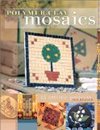More Polymer Clay Mosaics Reviews
After reviewing Laurie Mika's Mixed-Media Mosaics, I decided to look into what other polymer clay mosaic books were out there. Turns out there are two good ones with the same name: Polymer Clay Mosaics by Krista Wells and, well, Polymer Clay Mosaics by Sue Heaser. While both books are out of print, they're easy to find used. I got my hands on them and wanted to let you know my thoughts.
Polymer Clay Mosaics by Krista Wells
 Published in 2004, Krista Wells' Polymer Clay Mosaics
Published in 2004, Krista Wells' Polymer Clay MosaicsWells has a good grasp on polymer clay. Unlike Mika's book, which didn't adequately cover some polymer clay basics, I think this book would work fine for polymer clay beginners. This one has a nice amount of detail on all the basic techniques. It also includes some mosaic techniques that aren't just the same old ideas. I loved her tip for cardboard strips, and used it liberally for my latest batch of mosaic ATCs.
Wells includes the patterns for her projects, which she allows you to photocopy for your own non-commercial projects. Unfortunately, though, this leads me to one of the weaknesses of the book. She doesn't really go into the next steps — things like what would make a good design for a mosaic, or how to choose and modify a pattern to use for your own projects. I prefer books that help you think past the projects themselves, and this one didn't really do it for me.
My other complaint is that the book was lacking in step-by-step photos. Only one sample project had individual steps pictured. The other projects showed only the finished project. In some cases, it was difficult for me to understand the written steps without more visual clues. I would have preferred the book have fewer projects and more depth on the remaining projects.
Still, it was an enjoyable book. The projects were creative, and there were several that I really liked (faves include the CD Clock, Byzantime Clock, Thoroughly Modern Mondrian Mirror, & Klimt-Inspired Backsplash). I loved the quotes on creativity that were sprinkled throughout the book — a fun touch! Overall, this is a good (but not great) book if you're looking for lots of traditional mosaic projects.
Summary
- Title: Polymer Clay Mosaics
by Krista Wells
- Pros:
- Good descriptions of clay techniques
- A wide range of traditional mosaic projects
- Cons:
- Not enough step-by-step photos
- Doesn't include information on creating your own projects
- Who It's Good For: Polymer clay beginners will find good clay information here. Intermediate clayers will enjoy the wide range of fun projects. This book is ideal for folks who like to create projects just like they are in the book.
Polymer Clay Mosaics by Sue Heaser
 Written in 2003, Sue Heaser's Polymer Clay Mosaics
Written in 2003, Sue Heaser's Polymer Clay MosaicsThe section on clay basics is well-done. It includes clear instructions on all the techniques a beginner would need (like Skinner blends), but it also has some more advanced techniques (such as other blends and applique) that might interest intermediate clayers. Her graph paper technique for cutting tiles is a nice solution.
Heaser covers four types of clay mosaics in this book:- Classical Mosaics: These are typical tile mosaics with grout. I like that she gives advice on how much grout to mix up for an area. She also has good tips on layout, such as how best to cut pieces to fit around other pieces.
- Micro Mosaics: These mosaics use tiny soft-on-soft clay pieces, cut to form an image. This is very delicate-looking work, but I love the idea and am eager to try it.
- Pietre Dure Mosaics: This is a type of inlay technique. While she cautions that this is a difficult technique, I like that she has the projects in order of increasing difficulty so you can ease into the technique.
- Tile Mosaics: These are tiled mosaics without the grout. These projects use transfers, stamping, and cutters to make them look great without a lot of effort. This section includes one of my favorite projects in the whole book, the Herb Fossil Picture Frame.
I really like how Heaser gives tips on taking the next step creatively. For example,
she tells us which types of images make good mosaic patterns. And almost every project has ideas for other variations.
Another plus for this book is that it has lots of step-by-step photos. You won't get lost with these instructions!
If you only buy one mosaic book, this is the one I recommend. The fact that it includes several different mosaic types makes it more of a toolbox than the other books — a place you can learn techniques that will serve you in a variety of projects.
Summary
- Title: Polymer Clay Mosaics
by Sue Heaser
- Pros:
- Great instructions for four mosaic techniques and a wide variety of projects. All projects include step-by-step photos.
- Pointers for taking the next step in creating your own designs
- Cons:
- The book is out of print. Amazon has good prices on used versions, though, and I get the impression Heaser's new Encyclopedia of Polymer Clay Techniques
includes at least some of this information.
- The book is out of print. Amazon has good prices on used versions, though, and I get the impression Heaser's new Encyclopedia of Polymer Clay Techniques
- Who It's Good For: Beginner clayers will find a good foundation here. Intermediate clayers will likely find techniques, projects, and ideas to inspire them. And anyone interested in mosaics will enjoy learning about the different types.

